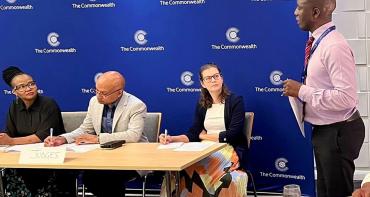Interim Statement

The Commonwealth Observer Group has been present in Kenya since 25 February 2013. During this period we have met with the Independent Electoral and Boundaries Commission (IEBC), representatives of political parties, civil society, media, Commonwealth High Commissions as well as other international and national observers. Commonwealth teams were based in seven of the Provinces. Our teams observed the voting, counting and results aggregation and also met with electoral officials, observers and other stakeholders at the County level to build up a larger picture on the conduct of the process.
This is the interim statement of the Commonwealth Observer Group, and it is issued with the process yet to be completed as the critical tabulation and results processes are on-going. We will issue a Final Report at a later stage, containing our conclusions on the entire process.
Key Findings
- The 4 March 2013 elections were Kenya’s first General Elections under the new Constitution and a series of new laws governing the elections, and represent an integral step in the reform and devolution process. Citizens have voted for the President, National Assembly, Women Members of the Assembly, Senate, County Governors and County Assemblies; three of which are brand new elective representative institutions. These elections were also the first General Elections since the tragic events following the 2007 polls, and so a major test for the country and its institutions.
- On the day of the election Commonwealth observers reported positively on the voting and counting processes in the majority of places visited. There was a large turnout, particularly at the outset of the voting and this created some crowd management challenges, but overall people waited peacefully for their turn to vote. There were however reports of incidents in the Mombasa area prior to the opening of polling and these are regrettable. In cases where there were delays voting was extended to enable those persons still waiting to cast their votes. We did observe problems in some instances with the electronic voter identification machines, but this was alleviated by the use of the printed copy of the register as provided for in the regulations.
- The count at polling stations was conducted transparently, poll officials worked diligently and party agents were present to witness the outcome. The results tabulation is on-going and this is a critical part of the process. We note the electronic transmission of unofficial results for the presidential elections by Presiding Officers experienced problems in some areas and later the Chair of the IEBC announced there had been a broader failure of the electronic transmission process and they would instead await the physical delivery of official results. We remain hopeful that the full results will be available within a reasonable period. Further, late on 5 March the IEBC clarified that rejected votes should be included in the total number of votes cast when calculating whether a candidate had received a majority, which was not how provisional results had initially been presented.
- The 2013 elections were regulated by an entirely new legal framework, including the 2010 Constitution and the 2011 Elections Act, IEBC Act and Political Parties Act. While the finalisation of the legislation so close to the election creates some challenges and some aspects do raise concern, overall the new legal framework provides the basis for credible, inclusive and competitive elections.
- The elections were competitive, with freedom of association and participation rights provided for. However, the political party primaries were reportedly not well managed by the parties and were delayed virtually up to the deadline for nominations in order to minimize party hopping. This created unnecessary pressure on the IEBC and created challenges with regard to the ballot printing.
- The provision of special seats for women in the National Assembly and reserved seats for women, among other groups, in the Senate and County Assemblies, means the level of women’s representation is improved compared to the previous parliament. However, it is regretted that the gender quota provided for in the new constitution is yet to be enforced.
- The election campaign was largely peaceful. Given the background to these polls, the high level of competition between political contestants and the fact that politics in Kenya retains a strong ethnic dimension, the peaceful campaign was both highly welcomed and commended. This environment was facilitated in no small measure by the large peace rally in Nairobi attended by leading candidates, the positive and constructive tone of the presidential debates, the numerous calls for peace from senior figures and a more responsible coverage by media. Campaign rights were provided for and candidates enjoyed freedom of movement and assembly, though it is unfortunate that adequate legislation on campaign funding and expenditure was not in place for these polls in order to provide for a higher level of transparency and accountability in this regard.
- The IEBC faced a challenging task in organizing the elections, not least because in a short period of time it was tasked with conducting nationwide boundary delimitation, a brand new biometric voter registration and preparing for six polls on a single day for multiple institutions some of which are just being created; all in the context of a brand new legal framework. Throughout the preparation for the polls public confidence in the IEBC was reported to be high, which, given the loss of confidence in the previous electoral management body following the 2007 polls, is commendable, and overall the IEBC managed the preparations in a transparent and effective manner.
- In such an environment and faced with late changes to the legislation the IEBC did struggle to contend with some truncated electoral deadlines and shortcomings. For instance, the IEBC’s voter education campaign, which is critical given the new system and complexity of the voting process, was initiated relatively late in the process. Problems and delays with the procurement of materials for the biometric voter registration and the reduced period for voter registration both impacted on the process. But overall, while the inclusion rate on the list can probably be further improved for the future, the new register represents a major effort and generally provides for universal suffrage.
- It is important to note that the results process is yet to be completed and should there be any legal disputes they will have to be resolved using the prescribed channels. Based on the process up to this point the 2013 polls represent a major effort on behalf of the IEBC and other institutions to conduct genuine elections. We urge the IEBC to ensure clarity and to complete the process in a transparent and timely manner. We also urge all parties and their supporters to be patient and calm and continue to play their part as they have done so far and ensure that Kenya’s reputation is enhanced as a result of these elections.
The Electoral Framework and Election Administration
The outgoing parliament passed the new electoral legislation, but they did so in some cases quite late resulting in a contracting of the electoral calendar or with various amendments which were not always helpful to the effective administration and management of the process. For instance, the voter registration period was reduced from 90 days before elections to 60 days; and, the requirement for a minimum period a candidate had to have been a member of a party in order to qualify for nomination was reduced from three months until the day of nominations, thereby facilitating party hopping up to the last moment.
The IEBC set a figure of 18 million as the potential eligible electorate. During the 30 day registration period which was eventually provided for, the IEBC registered some 14.3 million persons. While the registering of 14.3 million persons in just 30 days is an impressive figure, such a truncated period of registration for such crucial elections is unfortunate. The start of registration had been delayed following delays in the decision regarding the system of registration to be used and problems with the procurement process. There were also some delays in the finalisation and certification of the lists due to the time required for the cleaning and correcting of data. Final figures indicate that some 13,000 people were double registered and therefore excluded from voting.
There is a higher level of confidence and trust in the independence of the judiciary following reforms and new appointments among judges at various levels. This is very positive in the context of the elections and more broadly. It was also positive that Courts sought to fast track electoral matters and that informal mechanisms existed, such as the Political Party Liaison Committees, to resolve conflicts between parties.
The Election Campaign and Political Participation
The election campaign was reportedly generally peaceful. There were some local incidents and also tensions in some areas where there had been pre-existing problems, such as in the Tana River. But overall candidates and parties held numerous rallies and meetings throughout the country and were able to freely assemble and express their views. The numerous calls for peace by leading figures helped foster this conducive climate, as did the high profile peace rallies, such as the large one in Nairobi the week before the election. The presidential debates also helped focus attention on the issues and candidates engaged in them in a constructive manner. Further, the absence of hate speech in media and a more balanced coverage by media generally also contributed to the positive assessment of the election campaign.
The level of women’s representation in elective institutions under the current dispensation is improved compared to previously when just 10% of the members of parliament were female. Now there are 47 special seats for women in the National Assembly, 16 seats allocated in the Senate from party lists and women members for County Assemblies. However, Article 27(8) of the Constitution states that the “State shall take legislative and other measures to implement the principle that not more than two-thirds of the members of elective or appointive bodies shall be of the same gender”. But following a decision of the Supreme Court, the implementation of this provision was postponed. It is hoped that for future elections the positive provision in the Constitution for more balanced gender representation is implemented.
Voting and Counting Procedures
The turnout of voters was high, with long queues at many polling places prior to the opening of polls at 06.00. In some voting centres there were thousands of registered voters which meant that there was a wait of several hours. Security was present and was on the whole effective in helping IEBC officers to manage crowds. Polling staff worked hard and diligently and while some places experienced problems with the biometric voter identification devices the provision of printed registers as a back-up meant that people were not disenfranchised. The holding of six elections at the same time meant that voting was sometimes slow. Further, the different colours used for the ballots were not sufficiently distinctive and many voters had a problem identifying the correct ballot box for the respective ballots.
The vote count in polling stations was transparent, with officials conducting the process in a deliberate and careful manner and party agents were present and able to scrutinize the process, ensuring transparency and accountability at that level. It is noted that the number of invalid votes is quite high. This is unfortunate but not unforeseeable given the complexity of the voting process and the relatively late effort of the IEBC’s voter education campaign. The tabulation process is on-going and the IEBC must retain its transparency in completing this and that any complaints are dealt with effectively to ensure accountability.
Nairobi, 6 March 2013



